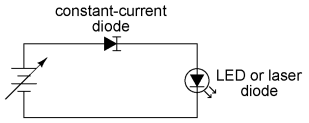| The ebook FEEE - Fundamentals of Electrical Engineering and Electronics is based on material originally written by T.R. Kuphaldt and various co-authors. For more information please read the copyright pages. |

|

Home  Semiconductors Semiconductors  Diodes and Rectifiers Diodes and Rectifiers  Special-Purpose Diodes Special-Purpose Diodes  Constant-current diodes Constant-current diodes |
|






|
|
|
Constant-current diodesConstant-current diode Current-limiting diode Current-regulating diode Diode, constant-currentA constant-current diode, also known as a current-limiting diode, or current-regulating diode, does exactly what its name implies: it regulates current through it to some maximum level. If you try to force more current through a constant-current diode than its current-regulation point, it simply "fights back" by dropping more voltage. If we were to build the following circuit and plot diode current over diode current, we'd get a graph that rises normally at first and then levels off at the current regulation point:
One interesting application for a constant-current diode is to automatically limit current through an LED or laser diode over a wide range of power supply voltages, like this:
Of course, the constant-current diode's regulation point should be chosen to match the LED or laser diode's optimum forward current. This is especially important for the laser diode, not so much for the LED, as regular LEDs tend to be more tolerant of forward current variations. Another application is in the charging of small secondary-cell batteries, where a constant charging current leads to very predictable charging times. Of course, large secondary-cell battery banks might also benefit from constant-current charging, but constant-current diodes tend to be very small devices, limited to regulating currents in the milliamp range.
|
|
Home  Semiconductors Semiconductors  Diodes and Rectifiers Diodes and Rectifiers  Special-Purpose Diodes Special-Purpose Diodes  Constant-current diodes Constant-current diodes |
|
Last Update: 2010-11-19



